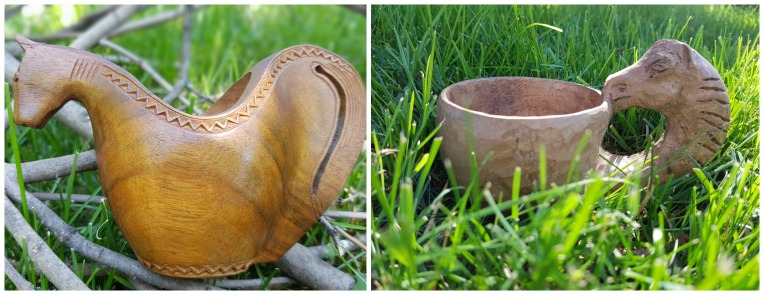Although this blog’s primary focus is costume and the textile material culture of the Serbs, I do hope to address other aspects of folk life, traditions and customs. Previous posts have shown easter customs and tools for the processing of wool; this time, I’d like to look at a specific type of wood carving, the kepčija.
Kepčije (pl) or kevčije are a type of carved wooden cup. The word is a turkism, from Turkish kepçe indicating a similar type of cup. In English, they are often called shepherd’s cups, but their use was not limited to shepherds.
 Shepherds definitely were known for their making and use of Kepčije. Wood carving was a good way to while away the time as they watched their herds or flocks, and they often carved whistles and flutes as well. They even kept track of things such as cheese produced or wool shorn using a carved recording system called a raboš. Using kepčije made sense for shepherds, as well as to field and vineyard workers, simply because of their durability.
Shepherds definitely were known for their making and use of Kepčije. Wood carving was a good way to while away the time as they watched their herds or flocks, and they often carved whistles and flutes as well. They even kept track of things such as cheese produced or wool shorn using a carved recording system called a raboš. Using kepčije made sense for shepherds, as well as to field and vineyard workers, simply because of their durability.
What really makes kepčije interesting is the intricacy of their designs. To be functional, they do not need any ornamentation. Cups carved out of very soft woods such as pine or birch were unadorned and utilitarian. These were mainly called merice (measuring cups) since they were used for that purpose, at market or in other tasks. But kepčije are invariably ornately carved, generally in three types of patterns: geometric, botanical, or animal.
Geometric designs prevailed in the western Dinaric zone, such as western Bosnia, Hercegovina, Dalmatia, and Lika. They can be simple zig zags etched into the wood, generally ash or maple (jasen, javor) or carved more deeply by cutting out triangular wedges. Expanding on this technique of cut wedges, a carver could obtain larger triangular shapes which, arranged in a circle, form rosettes. An example of this is shown in the kepčija cup from Bosansko Grahovo.

Spirals made up the other major geometric design. They were popular because they required more skill and much more patience in order to carve curved lines and keep them evenly spaced. These designs are found throughout all of the regions, especially in Dalmatia and Lika where, like the embroidery, such spirals are a very frequent ornament on wood, cloth, pottery and leather. The kepčija cups below show exquisite spiral designs. Both come from villages in the Knin – Dalmatinsko Kosovo area of Northern Dalmatia.

Botanic designs include flowers, leaves and stylized trees, especially varieties of oak (dub, hrast, cer). The stylized trees invariably consist of a central ‘trunk’ with symmetrical pairs of upward pointing branches. This is a variation of the tree of life (stablo života) known throughout the Balkans and particularly prominent in weaving. Botanic designs are frequent in the Sava River valley of Bosnia, Bosanska Posavina, as well as in Slavonija on the other side of the Sava. Slavonija experienced a wave of settlers from Bosnia during the Ottoman period, especially on the occasion of the formation of the Austrian Military Frontier in the 17th century, so many dinaric elements in costume and folk art can be found. The kepčije take on a ritual role in Slavonija, where they are used in wedding rituals, from inviting the guests to the series of ritual toasts or zdravice recited during the wedding feast. These were often very ornate and almost always botanically decorated. The kepčija from Slavonija, shown below, has a flower on the handle and very nicely carved acorns at the base of a stylized oak tree.

The Tree of Life – Stablo Života – design is prominent on these two kepčije, which are from villages in Bosanska Posavina and from Laktaši near Banja Luka.

Finally, animal ornamentation and symbolism. is the third category of decorative kepčije. Animals are carved most often on the musical instrument known as gusle. There, the most common elements are the eagle (orao), falcon (soko), mountain goats (divokoze), horses (konji) or mythical serpents and dragons. For kepčije, the animal most often shown is the horse. This animal was a much admired one, a symbol of masculinity and of wealth, as well as a useful domestic animal. Serbian culture is not as ‘equine’, let’s say, as Hungarian culture, but it is still a prominent and beloved animal. Carved kepčije with horses are shown below. The one on the left is a typical example, from the area around Knin; very simple, with a horse head at the front very similar to the way they are shown on gusle, and the tail cleverly included in the cup handle. It is beautiful for its simplicity of design. The other cup, on the right, is actually from Vojvodina – northern Banat, the vicinity of the town of Senta. It is not a typical kepčija, in that it has a rough hewn look, carved from ash wood. Still, it reflects the local population’s love of horses. Banat region is known for its excellence at horse breeding.
